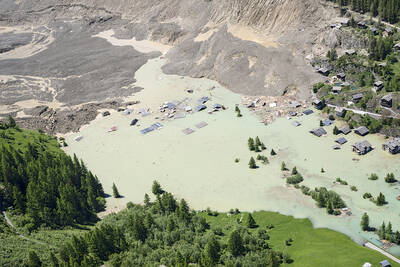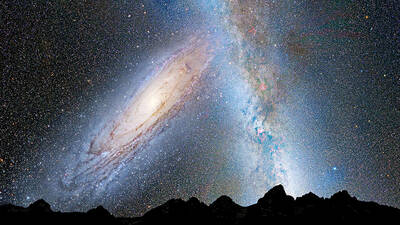A set of muddy Roman ruins discovered last month near a new UNESCO World Heritage site in the Netherlands is to be destroyed by reconstruction work on a dike, archeologists have said.
The 2,000-year-old canal and highway near the eastern city of Nijmegen surprised experts who were expecting to find only minor ruins during a routine dig ahead of work on the dike.
While a far cry from the famed bridges and amphitheaters found elsewhere in Europe, the Dutch ruins are just as important for understanding life on the far northern border of the Roman Empire along the Rhine River.
“The problem with Dutch archeology is that we don’t have large stone buildings, we don’t have a beautiful Pont du Gard... We just have mud,” project leader Eric Norde told Agence France-Presse, referring to a Roman aqueduct in southern France.
However, “this is quite a great find,” he said. “It is the first time we find a main Roman road, which leads from the Roman city of Nijmegen to the western part of the Netherlands and to the northern border of the Roman Empire.”
The more than 10m wide canal and the road are near the major Roman-era settlement with permanent military bases in Nijmegen that were awarded the UNESCO status last month.
The Limes, or outer border of the Roman empire, that passes through present-day Germany and the Netherlands “is already part of the UNESCO World Heritage, and this main road is part of it,” Norde said.
The archeologists struck lucky during a routine excavation before work to bulk up a dike, one of the huge earthworks that make up the low-lying Netherlands’ network of flood defenses.
Dutch laws brought in about 20 years ago make such studies obligatory to protect the invisible heritage below the ground.
“When we started, we thought we would find a regular Roman settlement. Instead of that, we found a main canal, which leads from the river Waal to the river Rhine. So that’s a great infrastructure,” said Norde, who works for RAAP, the country’s largest consultancy for archeology and cultural history.
The wide road, of which the original gravel coating has been preserved, “allows us to learn more about the road network from around 2,000 years ago,” Norde said.
The canal probably linked the city to the river and was used to transport soldiers, supplies and construction materials.
However, the team only has limited time to work on the “unique” find as it is soon to be covered up by the work on the dike.
Work is going ahead as planned on the dike, which is to offer flood protection in a part of the Netherlands that was last month hit by floods that also badly affected Germany and Belgium.
“All the elements will get lost,” Norde said.
Despite their importance, the Roman ruins were found after the designation of the UNESCO site and therefore do not officially form part of the heritage area, Norde added.
Had they been discovered before then, they would have formed part of the UNESCO region, he said.
However, Norde was stoical about the fate of the recently discovered parts, saying that archeologists were lucky that they had found them at all and that only a relatively small area would be covered up.
“The rest of the canal is safely 1.5 meters below the ground,” he said. “Fortunately, the road must have been about 60 kilometers long, and the Roman canal must have been about 20 kilometers long. So we have lots and lots to discover in the future.”

The collapse of the Swiss Birch glacier serves as a chilling warning of the escalating dangers faced by communities worldwide living under the shadow of fragile ice, particularly in Asia, experts said. Footage of the collapse on Wednesday showed a huge cloud of ice and rubble hurtling down the mountainside into the hamlet of Blatten. Swiss Development Cooperation disaster risk reduction adviser Ali Neumann said that while the role of climate change in the case of Blatten “still needs to be investigated,” the wider impacts were clear on the cryosphere — the part of the world covered by frozen water. “Climate change and

Poland is set to hold a presidential runoff election today between two candidates offering starkly different visions for the country’s future. The winner would succeed Polish President Andrzej Duda, a conservative who is finishing his second and final term. The outcome would determine whether Poland embraces a nationalist populist trajectory or pivots more fully toward liberal, pro-European policies. An exit poll by Ipsos would be released when polls close today at 9pm local time, with a margin of error of plus or minus 2 percentage points. Final results are expected tomorrow. Whoever wins can be expected to either help or hinder the

DENIAL: Musk said that the ‘New York Times was lying their ass off,’ after it reported he used so much drugs that he developed bladder problems Elon Musk on Saturday denied a report that he used ketamine and other drugs extensively last year on the US presidential campaign trail. The New York Times on Friday reported that the billionaire adviser to US President Donald Trump used so much ketamine, a powerful anesthetic, that he developed bladder problems. The newspaper said the world’s richest person also took ecstasy and mushrooms, and traveled with a pill box last year, adding that it was not known whether Musk also took drugs while heading the so-called US Department of Government Efficiency (DOGE) after Trump took power in January. In a

It turns out that looming collision between our Milky Way and Andromeda galaxies might not happen after all. Astronomers on Monday said that the probability of the two spiral galaxies colliding is less than previously thought, with a 50-50 chance within the next 10 billion years. That is essentially a coin flip, but still better odds than previous estimates and farther out in time. “As it stands, proclamations of the impending demise of our galaxy seem greatly exaggerated,” the Finnish-led team wrote in a study appearing in Nature Astronomy. While good news for the Milky Way galaxy, the latest forecast might be moot